National Aeronautics and Space Administration
Goddard Space Flight Center

Sun-Earth Day 2010: Magnetic Storms
Issue #71: Magnetism from A to B
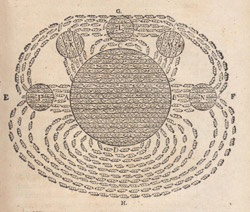
Figure 1: Rene Descartes drawing of a magnetic field (Principia Philosophiae; 1644)
Magnetism is a simple force, but many of its properties seem mysterious!
We have known about magnetism since at least the time of the Zhou Dynasty (1045-256 BC) in China when the properties of lodestone (magnetite) were explored as a means of direction-finding. In 1263 AD, a French amateur scientist Pierre de Maricourt used a compass to map the magnetic field of a lodestone, and discovered that a magnet had two magnetic poles: North and South. The actual mathematical details of how magnetism worked as a force had to await the investigations by William Gilbert and Rene Descartes in the 1600s, and Hans Christian, Andre Marie, Carl Friedrich Gauss, Hans Oerstead, Andre Ampere and Michael Faraday, among others in the early-1800s. In the 200 years since then, physicists have learned many basic things about why magnetism exists at all, and how it affects many different physical systems.
All magnetic fields are produced by moving or spinning charged particles…somewhere
Magnetism is a force in nature that is produced by electric fields in motion. This movement can involve electrons 'spinning' around atomic nuclei, flowing through a conducting wire, or ions moving through space in an organized stream. The remarkable thing is that whenever a charged particle moves, the electric field it produces is also moving through space, and it is this moving electric field that is detected as a magnetic field.
Electromagnets are created when electric currents move through a conducting wire. When you turn off the current by removing the battery, the magnetic field vanishes, so it is obvious that a current is involved in generating the magnetic field.
Permanent magnets (kitchen magnets) seem to contradict this rule, but in fact, they are magnetic because individual atoms with their 'orbiting' charged electrons are mostly lined up to create the overall 'permanent' magnet. The electron's orbital movement is the charged current that creates the magnetic field. Permanent magnets can be de-magnetized by heating them up. The jostling of the heated atoms eventually randomizes the directions of the atomic 'magnets', and the over-all field vanishes. In fact it is still there, the electrons still orbit their nuclei, but the magnetic domains in which the field is organized become smaller and smaller compared to the size of the magnet.
Quantum Magnets - According to the modern theory of atomic physics, called the Standard Model, electrons are fundamental particles. It is obvious that they are charged particles, but even stranger is that they act like miniature magnets themselves. This makes sense if we think of electrons as tiny planets with a surface that rotates about some axis. The negative electric charge on the surface moves as the electron spins, and this rotating surface current creates a small amount of magnetism. The problem is that electrons have no surface; they are mathematical points in space. Also, although they have a physical quantity we call 'spin' this is not the same thing we talk about when we discuss planets, although it seems to work in the same way! This means that the explanation we use for the origin of magnetism has to be drastically changed when we describe magnetism on the quantum scale of fundamental particles.
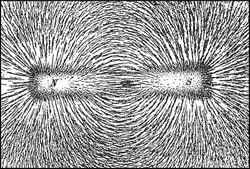
Figure 2: Bar magnet magnetic field showing two poles. (Practical Physics: 1914)
Magnetic poles always come in pairs.
There is no way to create a magnetic field with just a North Polarity or a South Polarity by themselves. Every charged current that creates a magnetic field, creates one that has exactly two poles, not a single pole in isolation. If you take a bar magnet and keep dividing it, you will never create fragments that have only one polarity! This is true even when your smallest fragment becomes a single electron. Magnetic polarity becomes a fundamental property of the object, and not the result of currents flowing in space. For other physical systems, such as the surface of the sun, you will often see sunspot groups where counting the number of North and South polarity regions does not lead to exactly equal numbers. This is because the missing regions may be spread out over the solar surface and not detectable unless you use better technology.
During the 1970's there were many experiments conducted to search for Magnetic Monopoles, because some theories of how forces and particles behaved proposed new particles that might have single poles. No search ever identified such particles. In fact, the modern theory of the Inflationary Big Bang was partly created to explain the absence of magnetic monopoles created during the Big Bang. The very few of these that were created are now so far apart and extremely rare in our universe that, even if they exist at all, they can never be detected on Earth.
Lines of magnetic force do not actually exist.
The iron filings we use to trace out magnetic fields are a handy way to study the direction and intensity of the magnetic field, but they are actually not real properties of the magnetic field itself. At best, they are only a mathematical tool we can use to visualize magnetic fields. The 'lines' appear because each iron filing acts as a north-south magnet and attracts its magnetized neighbors into longer segments, which eventually reach the two poles of the magnet and appear as an actual magnetic line in space.
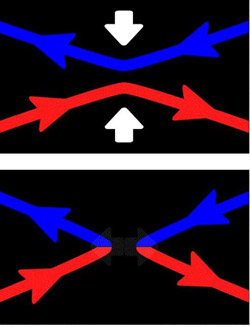
Figure 3: Top panel shows magnetic field before reconnection. Bottom shows magnetic field after resonnection.. (Courtesy: Center for Visual Computing: UC Riverside)
Magnetic Shape-shifting!
When magnetic fields are present within clouds of charged plasma it is possible for a magnetic field to change its shape. This process is called magnetic Reconnection, and it is one of the most important ways in which the energy stored in a magnetic field can be released. It cannot happen in a perfect vacuum because charged particles 9 ions, electrons, protons, nuclei) are required in order to create the currents that serve as the mid-wives of the changing process. They alsoWhen magnetic fields are present within clouds of charged plasma it is possible for a magnetic field to change its shape. This process is called magnetic Reconnection, and it is one of the most important ways in which the energy stored in a magnetic field can be released. It cannot happen in a perfect vacuum because charged particles 9 ions, electrons, protons, nuclei) are required in order to create the currents that serve as the mid-wives of the changing process. They also
Depending on your rate and direction of motion, a pure magnetic field can be turned into an electric field and vice versa.
If you applied a current to a wire it would produce a magnetic field. Suppose you traveled exactly in pace with the flow of the current. Would you still see a magnetic field? The answer according to both experiment and Einstein's Theory of Relativity, is that you would not see a magnetic field at all, because in your frame of reference, the charged particles are at rest. Instead, you would just see the electric fields of the charged particles 'sitting there' in space. According to Relativity, the intensity of the electric and magnetic fields you will measure in a particular frame of reference depends on your speed and direction of motion relative to the sources of the electric and magnetic fields.
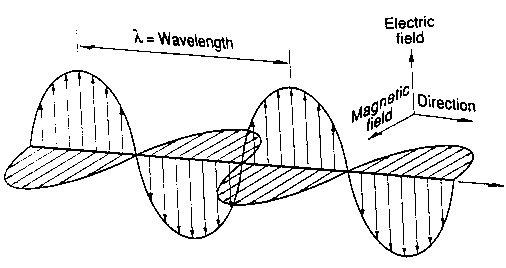
Figure 4: An electro-magnetic wave consists of an electric field and a magnetic field changing together in time and space.
Magnetic fields and electric fields are aspects of a more basic field in nature called the electromagnetic field.
In the 1800's, Michael Faraday combined all of the theories and laws that had been deduced for electric and magnetic fields into one 'electro-magnetic' theory. This highly mathematical theory could reproduce all of the experimental results on currents, electric fields and magnetic fields that were known by the mid-1800s, and made some very interesting predictions. Chief among these was that, at least for mathematical purposes, it was very convenient to think of electric fields and magnetic fields as separate aspects of a new electromagnetic field, which was the basic field in nature whose aspects we detect as magnetism under some conditions and electric fields under others. Physicists, for over a century, consider electromagnetic fields and electromagnetic forces as the main players in all phenomena that we once described separately in terms of magnetism or electricity. Another prediction from Faraday's electromagnetic theory was that the electromagnetic field can change in both time and space like a wave.
When physicists such as Heinrich Hertz explored the creation of these electromagnetic waves under laboratory conditions, they discovered that EM waves traveled at the speed of light, even though their wavelengths were many meters…what we now call radio waves. This led to the idea that visible light and the meter-wavelength EM waves were actually the same phenomenon, differing only in their wavelengths. The discovery of EM waves also led to a long-standing debate over what kind of medium was supporting these waves, and the ability of light to travel through a complete vacuum. Instead of water (water waves) physicists proposed a substance called the Luminiferous Ether. The Ether idea was finally disproved after numerous failures to detect it under laboratory conditions. When the 20th Century theory of quantum mechanics was applied to understanding fields in nature, it was finally recognized that EM waves do not need an independent medium to exist and move. The electric and magnetic fields generated by bodies are themselves the medium!
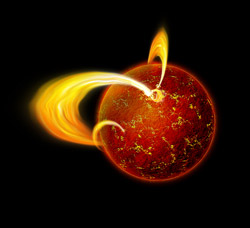
Figure 5: An artist's sketch of a magnetar showing a portion of its magnetic field. (Courtesy: NASA/Chandra)
How Much? How Little?
The strength of a magnetic field is usually measured in terms of units such as the Gauss or the Tesla, where one Tesla is equal to 10,000 Gauss. The Tesla is commonly used in high school physics textbooks that employ the SI metric system that uses meters, kilograms and seconds (called the MKS System). Astronomers use Gauss units because they are more convenient and easier to remember, and also because astronomers routinely use centimeters, grams, and seconds (CGS System) to describe astronomical systems. For example, Earth's magnetic field at the surface has a strength of 1/2 Gauss. This is easier to remember than 0.00005 Tesla (count those zeros carefully!). For practical purposes, a basic rule of is to use measurements that are appropriate to the scale of the system being studied. You do not use a kilometer as a length unit to measure the size of your classroom! Gauss units are also preferred because certain basic formulae in electromagnetism have a much simpler form using Gauss units rather than Teslas.
There is a very wide range of magnetic systems in the universe that span an enormous range of strengths. The common refrigerator magnet or toy bar magnet has a strength of about 100 Gauss. This is about 200 times stronger then the surface magnetic field of Earth (1/2 Gauss), and 50 times stronger then the typical surface magnetic field on the Sun. A sunspot can have a very intense magnetic field with a strength up to 5,000 Gauss, but the stronger the fields are, the faster the sunspots fly apart under the intense magnetic forces.
The strongest magnetic fields in nature are probably from magnetar stars such as SGR 1806-20, which has been estimated as 800 trillion Gauss. These stars are actually the remnants of the cores of massive stars that have become supernovae. The cores are so dense they are on the verge of becoming black holes! During the supernova explosion, the original star's magnetic field can become compressed and amplified as the core collapses into a rapidly-spinning neutron star. Typical surface fields of 10 - 100 Gauss can be amplified to trillions of Gauss in a matter of a few hours or less. Magnetars were discovered in the 1990s as the sources of intense bursts of gamma ray energy. From the data, astronomers concluded that these were produced by very young neutron stars with intense magnetic fields. Over thousands of years, these fields will weaken as the trapped magnetic energy is dissipated.
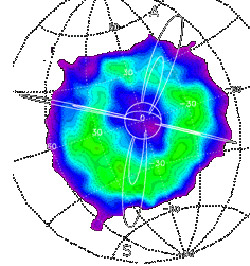
Figure 6: Earth's magnetic field is altered by currents of charged particles like the ones seen in this image. These currents lead to magnetic storms that can be detected on Earth, and that accompany aurora. (Courtesy: NASA/IMAGE)
Like the force of gravity, magnetism decreases the farther you are from the source, so when we look for the weakest sources of magnetism, we can always back away from any magnetic object and measure a steadily weakening magnetic field. The weakest magnetic fields in nature are found in a mixture of sources and settings. For example, a typical galaxy like the Milky Way has an average magnetic field strength of about 0.000003 Gauss (3 microGauss or 0.3 nanoTesla). The solar wind between the planets in our solar system has a slightly stronger strength of about 1 nanoTesla. The difference is that, while the Milky Way magnetic field is very weak, it encompasses a vastly greater volume of space than the solar wind, which also means that it stores far more energy!
Magnetic Ch…Ch...Ch…Changes!
Because electric currents can change in time and space, it is also true that magnetic fields can change their strength in time and space. If you take a permanent 'bar' magnet and change its temperature, the strength of its magnetic field will change with time as the magnetic domains grow and shrink in size. Earth was originally discovered to have a magnetic field by William Gilbert in 1600, and by the late 1700's many studies had shown that Earth's magnetism changes both in time and in space. Compass navigation relied on accurate bearings to traverse long distances to safe harbors, but over time these navigation charts had to be redrawn as the bearings changed slowly over the decades. It was also discovered that whenever the Northern Lights blazed in the sky, magnetic bearings on sensitive compasses would change up to several degrees in a few hours. These 'magnetic storms' were studied extensively in the early 1800's and were ultimately related to the appearance and disappearance of sunspots and solar storm events.
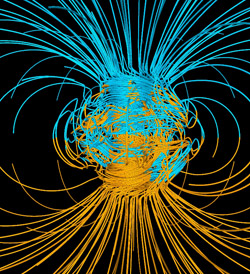
Figure 7: A mathematical model of Earth's magnetic field located in the Outer Core region (Courtesy: Gary Glatzmaier - Los Alamos National Laboratory)
The magnetic field of Earth is generated just outside its dense, hot core, which is a molten fluid rich in iron and nickel, and a perfect conductor of electric currents. These currents do not remain fixed in time and space, but drift slowly. This causes the magnetic poles of Earth to slowly wander across the surface of Earth over the span of thousands of years. The geographic location of Earth's North Magnetic Pole (the magnetic pole located in the Northern Hemisphere) is currently moving nearly due-North at a speed of 100 meters per day.
Most magnetic storms on Earth happen during the Equinoxes in March and September. The reason for this involves a complicated interaction between the orientation of Earth's magnetic field and the magnetic field of the sun when intense sunspot 'storms' are occurring. The rise and fall of magnetic storm activity on Earth parallels the sunspot cycle every 11 years. Currently in 2009 we are still in 'sunspot minimum' between the previous sunspot cycle (1996-2008) and the current sunspot cycle (2009-2020) and there are very few magnetic storm events each month. During sunspot maximum, there can be several major storms every week.
In addition to magnetic storms, there are other longer-term changes to Earth's magnetic field. Whenever volcanoes produce magma and the magma solidifies to rock, an imprint is registered of the direction and intensity of Earth's magnetic field. Geologists have measured Earth's magnetic field strength over thousands and even millions of years. At the present time, Earth's field is declining in strength by 5% every century. In a few thousand years, Earth may be temporarily without a magnetic field, except for the very weak remnants of ancient fields found in rocks)! This kind of behavior is not unusual for systems that create their own magnetic fields.
The sun's magnetic field declines, and actually reverses its polarity every 11 years. A full cycle of magnetic reversals (N-S to S-N to N-S) takes 22 years and is called the Hale Magnetic Cycle. Geologists have discovered that Earth does the same thing. Earth's magnetic poles reverse their geographic locations every 300,000 years or so. The last event happened 780,000 years ago. There have been hundreds of these magnetic reversals during the last 70 million years. The data from the last reversal 780,000 years ago indicates that it only takes a thousand years or less for the field to vanish, and rebuild itself in the new polarity phase. The time between earth's magnetic cycles seems to be slowly increasing. Geologists thinks this is because the core of Earth is cooling, and the currents are flowing more sluggishly as Earth ages.
The good news is that Magnetic pole 'reversals' have no effect on the rotational poles of a star or planet. The is no evidence in the fossil record of enhanced mutations or extinctions timed with these reversals, going back millions of years. The bad news is that the dazzling Auroras and beautiful curtains of light we admire in the arctic and Antarctic regions will disappear for a few centuries, and probably be replaced by colorful diffuse glows of light spanning the night sky!
In the next Issue, we will have a look at magnetic storms!
The Sun-Earth Connection
The behavior of magnetic fields accounts for many of the phenomena we call space weather, from flares on the sun to magnetic storms and aurora on earth.
Space Math Connection:
These problems are available at Space Math @ NASA (http://spacemath.gsfc.nasa.gov)
The Heliopause...A question of balance [Problem 114]
Students will learn about the concept of pressure equilibrium by studying a simple mathematical model for the sun's heliopause located beyond the orbit of Pluto. They will calculate the distance to the heliopause by solving for 'R' and then using an Excel spreadsheet to examine how changes in solar wind density, speed and interstellar gas density relate to the values for R. [Grade: 8-10 | Topics: Formulas with two variables; scientific notation; spreadsheet programming]Monster Sunspots! [Problem 107]
Students will determine the scale of three images of large sunspots including the Carrington Spot, and order the spots in increasing size [Grade 5-8; = Skills:=20 image scales; metric measurement]
Loopy Sunspots! [Problem 104]
Students will analyze data from the Hinode satellite to determine the volume and mass of a magnetic loop above a sunspot, and determine the total mass of the magnetically trapped material. [Grade: 9-11 | Topics:image scales; cylinder volume calculation; scientific notation; unit conversions]
Magnetic Math [Book]
This book features 40 mathematics problems related to the study of magnetism. [Grade 4-12; Skills: hands-on labs; pre-Algebra, Geometry, Algebra I, Algebra II]
References:
- SED-2005 Solar Observatories TTT 1-30
- SED-2006 - First observations of the sun by humans - TTT 31-47
SED-2007 - Solar Science:
- TTT 48 - The Sun from Cradle to Grave
- TTT 49 - Solar Energy
- TTT 50 - Ancient Sunlight
- TTT 52/6 - Solar activity and features
- TTT 57 - The Heliosphere
SED-2008 - Space Weather Around the World:
- TTT 58 - Why is the sun's corona hot?
- TTT 59 - Where did all the neutrinos go?
- TTT 60 - Where does the sun's magnetic field come from?
Credits:
Dr. Sten Odenwald (Author - Hinode)
View past issues
NASA Fact
Space Weather Forecasting costs only $5 million a year, but supports over $500 billion in annual revenue from the satellite and electrical power industries.
